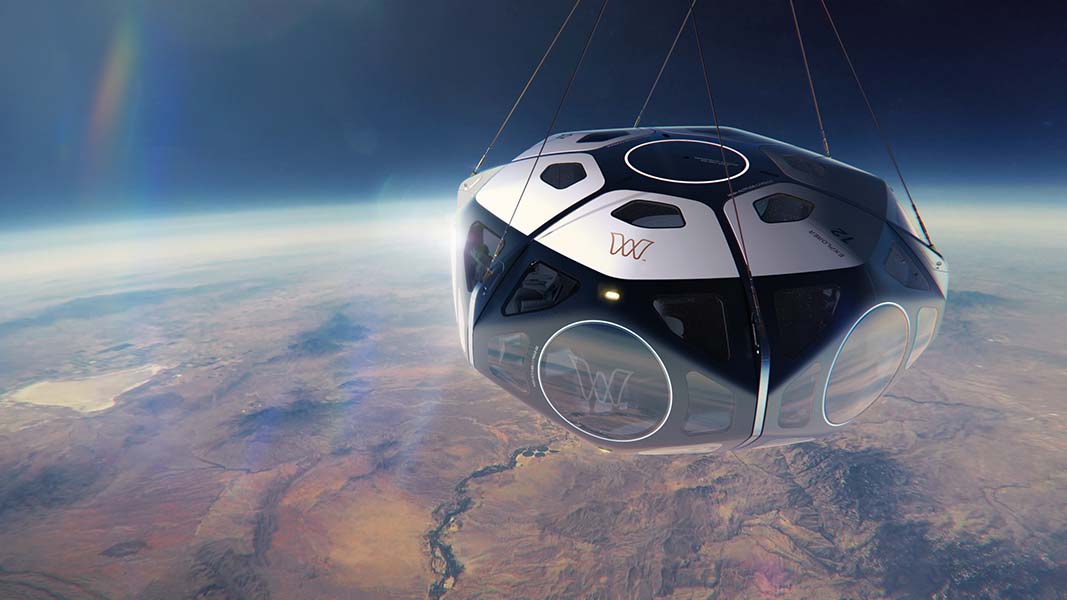As CEO of World View Enterprises, Ryan Hartman (’09) envisions a new kind of space tourism — one that doesn’t explore distant planets, but rather showcases the wonders of Earth.
“If people have a shifted perspective of our Earth, maybe they will find a newfound respect for our planet and make different decisions about how they treat it,” Hartman says.
Headquartered in Tucson, Arizona, World View recently announced plans to launch a stratospheric balloon more than 100,000 feet above the Earth, carrying a spacecraft capsule with eight passengers and two crew members, in 2024. The spacecraft would rise and hover, allowing for a view of the Earth, space and the curvature of the Earth, Hartman says.
Key to the plan is the construction of seven spaceports around the world, located near wonders that include the Grand Canyon in the U.S.; the Great Barrier Reef in Australia; the Great Wall of China in Mongolia; the Aurora Borealis in Norway; the Giza Pyramids in Egypt; Amazonia in Peru; and the Serengeti in Kenya.
Tourists would embark on a six- to eight-hour flight from one of the spaceports as part of a five-day immersive experience, which would also include on-the-ground excursions that would allow for a deeper understanding and appreciation of the place. For example, Hartman says, those who visit the Grand Canyon may experience the stratospheric balloon ride, plus a helicopter tour of the canyon and visits to local Native American communities.
“Through all those experiences, they are learning more about the Earth and the fragility and beauty of each of these places,” he says. “It’s an opportunity for customers to fully engage and experience our Earth.”
Aviation Innovation
For Hartman, leading World View is a culmination of his love of flight, innovation and adventure.
Growing up on his family’s Arizona cattle ranch, he heard stories about his father’s achievements as a bull rider. “My parents were to be married on July 4th in Prescott, Arizona,” he says. “But the bull riding finals were always on July 4th, and my dad entered the rodeo, made the finals and told my mom that they couldn’t be married on that day. So they had to be married the day before, and he came in second place.”
He credits his grandfather, who served in the Army Air Corps flying B-29s in WWII, for inspiring his love of aviation.
“He used to pick me up from school and take me to the Stagecoach Inn Cafe to eat and tell me stories,” Hartman recalls. “He had 10 or 12 stories that he just put on repeat.” His grandpa talked about the comradery of the pilots and aviation innovation, including when he witnessed the delivery of the first Boeing B-29.
“It just sounded so cool to be a part of that,” Hartman says. “I decided I wanted to be involved in aviation in some fashion.”
UAS Leader
After serving 10 years in the military, Hartman worked as a hardware engineer at Raytheon Corp., then led its Unmanned Systems Directorate of the Advanced Programs Division.

Through his unmanned aerial systems (UAS) work, he got to know Steve Sliwa, who was president of Embry-Riddle from 1991 to 1998. When Hartman met him, Sliwa was CEO of Insitu, Inc., which specializes in UAS for military and commercial applications. When Hartman accepted a business development job at Insitu, Sliwa became a mentor to him.
“Dr. Sliwa always talked about how you can put people in a position to be a rock star,” Hartman says. “If you are a strong cultural fit and have the skills, you can be a rock star.”
Eventually, Hartman, who is married with three sons, became CEO of Insitu, serving for four years in that role. “I lead in an unconventional way,” he says. “I lead from a place of passion and purpose, and I let everything fall into place.”
Insitu, now a wholly owned subsidiary of The Boeing Company, had about 200 employees when he joined the company, and it grew to 1,500 people by the time he left in 2018, Hartman says.
“When I left Insitu, we had customers in 27 countries around the world,” he says.
When World View hired him as CEO in 2019, its business was focused on using the advanced stratospheric balloon technology it had developed for persistent remote sensing, communications, weather and research for commercial and government customers. “Stratospheric balloons are a very earth-friendly way of getting people or sensors to the edge of space,” Hartman says. “They use renewable and natural resources, not jet fuel.”
The company’s balloons, known as Stratollites, collect images and data closer to Earth than traditional satellites, so they offer outstanding resolution and accuracy for viewing strategic geography, while providing persistent coverage without weather constraints. They can be used for everything from monitoring an oil pipeline or powerline to tracking storms, he says.
New Horizons
While the remote sensing line of business will remain, World View is excited to embark on its new space tourism venture, which Hartman believes could have a healing impact on the Earth and humankind.

“We are not interested in being in the space tourism market focused on getting away from the Earth,” he says. “We are talking about the importance of going to the stratosphere and rediscovering the Earth. That is very important to us — we want people to come away with a newfound appreciation and respect for the planet.”
Space tourism should also be about time, place, affordability and accessibility, Hartman says. World View’s tickets will start at $50,000, with financing offered. And the helium-filled, zero-pressure balloon flight system, instead of a rocket, will allow for a gentler ascent from the spaceport. The balloon will hover at more than 100,000 feet for up to eight hours, then start its gradual descent. To land, the capsule will deploy a patented parafoil system, separate from the balloon, and then navigate to a landing zone near the spaceport.
Passengers will not experience weightlessness in the pressurized capsule, so the flight is accessible for most people, ages 18 and up, without special training, he says. An operator and a concierge will accompany passengers on each flight. Ultimately, he predicts World View’s space tourism will radically impact passengers’ lives and lead to them becoming conservation advocates.
“My career is a great example of intersecting passion and purpose with opportunity,” Hartman says. “One of the things Embry-Riddle represents for me is that you can control your own destiny. If you have a dream, you can make it happen. It may not be the easy or conventional path, but you can make it happen.”
